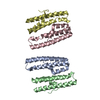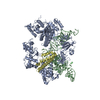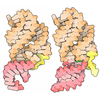+ Open data
Open data
- Basic information
Basic information
| Entry | Database: PDB / ID: 8ja0 | |||||||||||||||||||||||||||||||||||||||
|---|---|---|---|---|---|---|---|---|---|---|---|---|---|---|---|---|---|---|---|---|---|---|---|---|---|---|---|---|---|---|---|---|---|---|---|---|---|---|---|---|
| Title | Cryo-EM structure of the NmeCas9-sgRNA-AcrIIC4 ternary complex | |||||||||||||||||||||||||||||||||||||||
 Components Components |
| |||||||||||||||||||||||||||||||||||||||
 Keywords Keywords | RNA BINDING PROTEIN/RNA / a protein complex / VIRAL PROTEIN / RNA BINDING PROTEIN-RNA complex | |||||||||||||||||||||||||||||||||||||||
| Function / homology |  Function and homology information Function and homology informationmaintenance of CRISPR repeat elements / endonuclease activity / defense response to virus / Hydrolases; Acting on ester bonds / DNA binding / RNA binding / metal ion binding Similarity search - Function | |||||||||||||||||||||||||||||||||||||||
| Biological species |  Neisseria meningitidis (bacteria) Neisseria meningitidis (bacteria) Haemophilus parainfluenzae (bacteria) Haemophilus parainfluenzae (bacteria) | |||||||||||||||||||||||||||||||||||||||
| Method | ELECTRON MICROSCOPY / single particle reconstruction / cryo EM / Resolution: 3.52 Å | |||||||||||||||||||||||||||||||||||||||
 Authors Authors | Yin, H. / Li, Z. / Yu, G.M. / Li, X.Z. | |||||||||||||||||||||||||||||||||||||||
 Citation Citation |  Journal: Nucleic Acids Res / Year: 2023 Journal: Nucleic Acids Res / Year: 2023Title: Inhibitory mechanism of CRISPR-Cas9 by AcrIIC4. Authors: Xuzichao Li / Fumeng Liao / Jiaqi Gao / Guangyong Song / Chendi Zhang / Nan Ji / Xiaoshen Wang / Jing Wen / Jia He / Yong Wei / Heng Zhang / Zhuang Li / Guimei Yu / Hang Yin /  Abstract: CRISPR-Cas systems act as the adaptive immune systems of bacteria and archaea, targeting and destroying invading foreign mobile genetic elements (MGEs) such as phages. MGEs have also evolved anti- ...CRISPR-Cas systems act as the adaptive immune systems of bacteria and archaea, targeting and destroying invading foreign mobile genetic elements (MGEs) such as phages. MGEs have also evolved anti-CRISPR (Acr) proteins to inactivate the CRISPR-Cas systems. Recently, AcrIIC4, identified from Haemophilus parainfluenzae phage, has been reported to inhibit the endonuclease activity of Cas9 from Neisseria meningitidis (NmeCas9), but the inhibition mechanism is not clear. Here, we biochemically and structurally investigated the anti-CRISPR activity of AcrIIC4. AcrIIC4 folds into a helix bundle composed of three helices, which associates with the REC lobe of NmeCas9 and sgRNA. The REC2 domain of NmeCas9 is locked by AcrIIC4, perturbing the conformational dynamics required for the target DNA binding and cleavage. Furthermore, mutation of the key residues in the AcrIIC4-NmeCas9 and AcrIIC4-sgRNA interfaces largely abolishes the inhibitory effects of AcrIIC4. Our study offers new insights into the mechanism of AcrIIC4-mediated suppression of NmeCas9 and provides guidelines for the design of regulatory tools for Cas9-based gene editing applications. | |||||||||||||||||||||||||||||||||||||||
| History |
|
- Structure visualization
Structure visualization
| Structure viewer | Molecule:  Molmil Molmil Jmol/JSmol Jmol/JSmol |
|---|
- Downloads & links
Downloads & links
- Download
Download
| PDBx/mmCIF format |  8ja0.cif.gz 8ja0.cif.gz | 284.2 KB | Display |  PDBx/mmCIF format PDBx/mmCIF format |
|---|---|---|---|---|
| PDB format |  pdb8ja0.ent.gz pdb8ja0.ent.gz | 216.9 KB | Display |  PDB format PDB format |
| PDBx/mmJSON format |  8ja0.json.gz 8ja0.json.gz | Tree view |  PDBx/mmJSON format PDBx/mmJSON format | |
| Others |  Other downloads Other downloads |
-Validation report
| Arichive directory |  https://data.pdbj.org/pub/pdb/validation_reports/ja/8ja0 https://data.pdbj.org/pub/pdb/validation_reports/ja/8ja0 ftp://data.pdbj.org/pub/pdb/validation_reports/ja/8ja0 ftp://data.pdbj.org/pub/pdb/validation_reports/ja/8ja0 | HTTPS FTP |
|---|
-Related structure data
| Related structure data |  36123MC  7xvqC M: map data used to model this data C: citing same article ( |
|---|---|
| Similar structure data | Similarity search - Function & homology  F&H Search F&H Search |
- Links
Links
- Assembly
Assembly
| Deposited unit | 
|
|---|---|
| 1 |
|
- Components
Components
| #1: Protein | Mass: 124613.883 Da / Num. of mol.: 1 Source method: isolated from a genetically manipulated source Source: (gene. exp.)  Neisseria meningitidis (bacteria) / Gene: cas9, NMV_1993 / Production host: Neisseria meningitidis (bacteria) / Gene: cas9, NMV_1993 / Production host:  References: UniProt: C9X1G5, Hydrolases; Acting on ester bonds |
|---|---|
| #2: Protein | Mass: 9985.316 Da / Num. of mol.: 1 Source method: isolated from a genetically manipulated source Source: (gene. exp.)  Haemophilus parainfluenzae (bacteria) / Gene: NCTC10672_00033, NCTC10672_02354 / Production host: Haemophilus parainfluenzae (bacteria) / Gene: NCTC10672_00033, NCTC10672_02354 / Production host:  |
| #3: RNA chain | Mass: 37367.059 Da / Num. of mol.: 1 Source method: isolated from a genetically manipulated source Source: (gene. exp.)  Neisseria meningitidis (bacteria) / Production host: Neisseria meningitidis (bacteria) / Production host:  |
| Has protein modification | N |
-Experimental details
-Experiment
| Experiment | Method: ELECTRON MICROSCOPY |
|---|---|
| EM experiment | Aggregation state: PARTICLE / 3D reconstruction method: single particle reconstruction |
- Sample preparation
Sample preparation
| Component | Name: a protein complex / Type: COMPLEX / Entity ID: all / Source: MULTIPLE SOURCES |
|---|---|
| Source (natural) | Organism:  Neisseria meningitidis (bacteria) Neisseria meningitidis (bacteria) |
| Source (recombinant) | Organism:  |
| Buffer solution | pH: 7.5 |
| Specimen | Embedding applied: NO / Shadowing applied: NO / Staining applied: NO / Vitrification applied: YES |
| Vitrification | Cryogen name: ETHANE |
- Electron microscopy imaging
Electron microscopy imaging
| Experimental equipment |  Model: Titan Krios / Image courtesy: FEI Company |
|---|---|
| Microscopy | Model: FEI TITAN KRIOS |
| Electron gun | Electron source:  FIELD EMISSION GUN / Accelerating voltage: 300 kV / Illumination mode: FLOOD BEAM FIELD EMISSION GUN / Accelerating voltage: 300 kV / Illumination mode: FLOOD BEAM |
| Electron lens | Mode: BRIGHT FIELD / Nominal defocus max: 2500 nm / Nominal defocus min: 500 nm |
| Image recording | Electron dose: 40 e/Å2 / Film or detector model: GATAN K3 (6k x 4k) |
- Processing
Processing
| Software | Name: PHENIX / Version: 1.20.1_4487: / Classification: refinement | ||||||||||||||||||||||||
|---|---|---|---|---|---|---|---|---|---|---|---|---|---|---|---|---|---|---|---|---|---|---|---|---|---|
| CTF correction | Type: PHASE FLIPPING ONLY | ||||||||||||||||||||||||
| 3D reconstruction | Resolution: 3.52 Å / Resolution method: FSC 0.143 CUT-OFF / Num. of particles: 251996 / Symmetry type: POINT | ||||||||||||||||||||||||
| Refine LS restraints |
|
 Movie
Movie Controller
Controller



 PDBj
PDBj





























